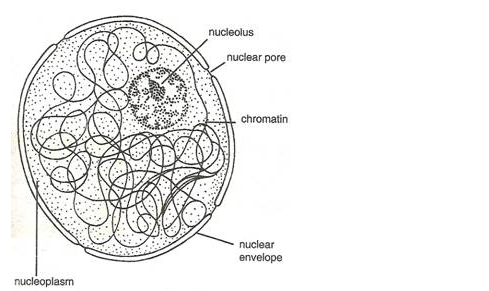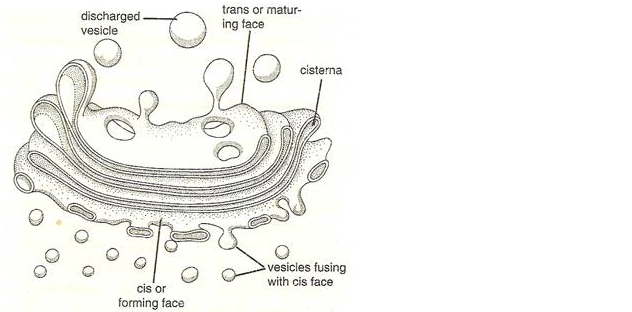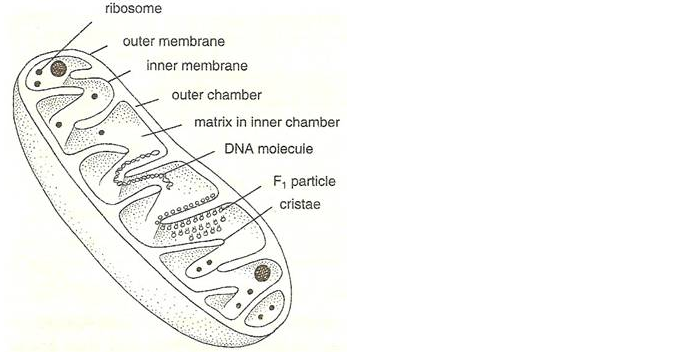Formulae Handbook for Class 9 Maths and Science
PS Verma Biology Class 9 Chapter 2 – The Fundamental Unit Of Life – Cell
Text Book Solutions – P.S.Verma and V.K.Agarwal – Biology
CBSE Class 9 Chapter 2 – The Fundamental Unit Of Life – Cell
Share Queries and Discuss your Views and Ideas – LearnCBSE Forum
PS Verma and V.K. Agarwal Biology Class 9 Page No – 116.
Solution SAQ – 1:
Prokaryotic Cell:
1. Cell size is generally small.
2. Only a single chromosome is present.
3. Nucleolus is absent.
4. Cell division takes place by fission or budding.
Eukaryotic Cell:
1. Cell is generally large.
2. More than one chromosome is present.
3. Nucleolus is present.
4. Cell division takes place by mitotic or meiotic.
Solution SAQ – 2:
Organs:
1. They are found in multicellular organisms.
2. They are large sized.
3. They may be external or internal to the body of organisms.
4. Organs coordinate to form organ systems, while organ systems form the body of an organism.
Organelles:
1. They are found in all eukaryotic cells.
2. They are very small sized.
3. They are mostly internal.
4. Organelles coordinate to produce the cell.
Solution SAQ – 4:
Light microscope:
1. It uses glass lenses.
2. It uses a beam of light to illuminate the object.
3. Internal vacuum is not required.
Electron microscope:
1. It uses electromagnets.
2. It uses a beam of electrons instead of light.
3. Internal vacuum is essential.
Solution SAQ – 5:
Robert Hooke examined a thin slice of cork under a self-designed crude microscope and observed that the cork resembled the structure of a honey comb. The latter consisted of many tiny compartments. Hooke called them cellulae (Singular cellula), now termed cells. Cellula is a Latin name which means a ‘little room’. Such rooms were also present in monasteries.
Solution SAQ – 6:
There are two types of protein molecules: Intrinsic proteins, which completely covers the lipid bilayer and extrinsic proteins, which occur either on the outer surface or on the inner surface of the lipid membrane.
Solution SAQ – 7:
Its major function is to hold cellular contents and control passage of materials in and out of the cell.
Solution SAQ – 8:
In amoeba, oxygen (O2) enters the cell by the process of diffusion when the level or concentration of O2 inside the cell decreases.
Solution SAQ – 9:
Put dried raisins and apricots in pure water and leave them for some time. Then place them into a concentrated Solution of sugar or salt. Each one of them gains water and swells when placed in pure water due to endosmosis. When such swollen raisins/apricots are placed in the concentrated Solution, each of them loses, water, and consequently shrinks again (due to exosmosis).
Solution SAQ – 10:
Diffusion:
1. Diffusion can occur in any medium.
2. The diffusing molecules may be solids, liquids or gases.
3. Semipermeable membrane is not required.
4. An equilibrium in the free energy of diffusion molecules is achieved in the system.
Osmosis:
1. It occurs only in liquid medium.
2. It involves movement of solvent molecules only.
3. Semipermeable membrane is required.
4. Equilibrium in the free energy of solvent molecules is never achieved.
Solution SAQ – 11:
Endocytosis is the ingestion of material by the cells through the plasma membrane. It is a collective term that describes three similar processes: phagocytosis (cell eating), potocytosis (cell drinking) and receptor-mediated endocytosis. These processes are pathways to specifically internalize solid particles, small molecules ion, and macromolecules, respectively. All of them require energy, so they may be regarded as different forms of active transport.
Solution SAQ – 12:
(i) When eukaryotic cells are placed in hypotonic Solution, the water molecules will enter into the cell and the cell will swell up.
(ii) If eukaryotic cells are placed in hypertonic Solution, the water molecules will come out of the cell and the cell with shrink.
(iii) If the eukaryotic cell is placed in isotonic Solution, the amount of water molecule will remain the same; it will neither move out nor will go inside. The cell will remain same sized.
Solution SAQ – 13:
(a) Ribosome.
(b) Plastid in plants and Mitochondria in animals.
(c) Rough endoplasmic reticulum.
(d) Genes.
Solution SAQ – 14:
(a)
Chloroplasts:
1. They are green plastids.
2. They contain chlorophylls and carotenoids.
3. Lamellae are present.
4. Chloroplasts are sites of photosynthesis.
Chromoplasts
1. They are non-green coloured plastids.
2. Chlorophylls are absent. Only carotenoids are present.
3. Lamellae are absent.
4. They add colour to the organs for attracting animals to perform pollination and fruit dispersal.
(b)
Ribosome:
1. It is found in both animal cell and plant cell.
2. These are dense, spherical and granular particles which occur freely in the matrix or remain attached to the endoplasmic reticulum.
Centrosome:
1. Centrosome is found only in animal cells.
2. It consists of two granules like centrioles.
Solution SAQ – 15:
Animal Cell:
1. Animal cells are generally small in size.
2. Cell wall is absent.
3. Animal cells have a single highly complex and prominent Golgi apparatus.
4. Animals cells have centrosome and centrioles.
Plant Cell:
1. Plant cells are larger than animal cells.
2. The plasma membrane of plant cell is surrounded by a rigid cell wall made up of cellulose.
3. Plant cells have many simpler units of Golgi apparatus, called dictyosomes.
4. Plant cells lack centrosome and centrioles.
Solution SAQ – 16:
If nucleus is removed from a cell, the protoplasm will ultimately dry up and the cell will die because the nucleus controls all the metabolic activities of a cell.
PS Verma and V.K. Agarwal Biology Class 9 Page No – 117.
Solution SAQ – 17:
Spinach looks green due to the presence of chloroplasts, papaya is yellow and edible part of watermelon is red due to the presence chromoplasts.
Solution SAQ – 18:
(a) Functions of endoplasmic reticulum:
(i) It forms supporting skeletal framework of the cell.
(ii) ER provides a pathway for the distribution of nuclear material from one cell to the other.
(b) Functions of lysosomes:
(i) Lysosomes serve as intracellular digestive system. They destroy any foreign material which enters the cells such as bacteria and virus.
(ii) Lysosomes also remove the worn out and poorly working cellular organelles by digesting them to make way for their new replacements.
Solution SAQ – 19:
(a) Ribosome.
(b) Leucoplasts.
Solution SAQ – 20:
Lysosomes contain digestive enzymes for almost all types of organic materials. If their covering membrane breaks as it happens during injury to cell, the digestive enzymes will spill over the cell contents and digest the same. As Lysosomes are organelles which on bursting can kill cells possessing them, they are called suicide bags.
Solution SAQ – 21:
(a) Cell Inclusions – Cell inclusions are non-living materials present in the cytoplasm.
(b) Cytosol – It is the soluble part of cytoplasm and is located between cell organelles.
(c) Protoplasm – Nucleus and cytoplasm together are called protoplasm.
(d) Nucleoplasm – It is the liquid ground substance present in the nucleus.
Solution SAQ – 22:
Ribosomes get synthesized in the nucleolus.
Solution SAQ – 23:
(a) The mitochondria are tiny bodies of varying shapes and size. Each mitochondria is bounded by a double membrane envelope. Outer membrane is porous. The inner membrane is thrown into folds. These folds are called cristae and are studded with small rounded bodies known as F1 particles or oxysomes. The interior cavity of the mitochondria is filled with a proteinaceous matrix which contains a few small-sized ribosomes, a circular DNA molecule and phosphate granules. Mitochondria are sites of cellular respiration.
(b) Plastids occur in most plant cells and are absent in animal cells. They have their own genome and ribosomes. There are three types of plastids: chromoplasts, chloroplasts and leucoplasts.
Solution SAQ – 24:
The cell organelles are – Endoplasmic Reticulum, Ribosomes, Golgi apparatus, Lysosomes, Mitochondria, Plastids, Vacuoles, Peroxisomes and Centrosome.
Solution SAQ – 25:
The three main functional regions of the cell are: Plasma membrane, Nucleus and the cytoplasm.
Solution SAQ – 26:
(a) Nucleus.
(b) Nucleus.
(c) Vacuoles.
(d) Nucleus.
Solution SAQ – 27:
Genes are the functional units of chromosomes which transmit the heredity information from parents to offsprings. These are located on chromosomes.
Solution SAQ – 28:
Lysosomes are called digestive bags because they digest any foreign material which enters the cell such as bacteria and virus.
Solution SAQ – 29:
Mitochondria is called the power plant of eukaryotic cell because it contains enzymes that are needed for the step wise oxidation of food stuffs present in the cells to carbon dioxide and water and energy is released.
Solution SAQ – 30:
Centrioles – Centrioles are hollow and cylindrical structures which are made up of microtubules.
Functions: (i) It migrates to the poles of animal cells and is involved in the formation of the spindle.
(ii) In plant cells, cell division involves polar caps for the spindle formation.
Solution SAQ – 31:
Lipids gets synthesised in the smooth endoplasmic reticulum and proteins gets synthesised in the ribosomes and rough endoplasmic reticulum.
Solution SAQ – 32:

Solution SAQ – 33:
Plasmolysed cell means the cell in which the water crosses the plasma membrane in both directions but more water leaves the cell than enters it and the cell will shrinks.
Solution LAQ – 1:
According to fluid mosaic model, plasma membrane is made up of a bilayer of phospholipids. There are two types of protein molecules: Intrinsic Proteins, which completely covers the lipid bilayer and Extrinsic Proteins, which occur either on the outer surface or on the inner surface of the lipid membrane.
The fluid mosaic membrane has been described as “a number of protein icebergs floating in the sea of lipids”.

Solution LAQ – 2:

Functions of cell organelles:
(i) Endoplasmic Reticulum – It forms the supporting skeletal framework of the cell.
(ii) Ribosomes – It synthesises proteins.
(iii) Golgi Apparatus – It produces vacuoles which contain cellular secretion.
(iv) Lysosomes – It serves as intracellular digestive system as it digest the foreign materials which enter the cell.
(v) Mitochondria – These are the sites of cellular respirations
(vi) Plastids – These are present only in plants and trap solar energy to manufacture food for plants.
(vii) Vacuoles – They help to maintain the osmotic pressure in a cell.
(viii) Peroxisomes – They carry out some oxidative reactions.
(ix) Centrosome – It helps in cell division in the animal cell.
Solution LAQ – 3:
Nucleus – The nucleus is a large, centrally located spherical cellular component. It is bounded by two nuclear membranes, both forming a nuclear envelope. The nuclear envelope separates the nucleus from the cytoplasm. Within nucleoplasm two types of nuclear structures are embedded – the nucleolus and chromatin material. The nucleolus may be one or more in number and is not bounded by any membrane. It is rich in protein and RNA molecules and acts as the site for ribosome formation.

Solution LAQ – 4:
(a) Golgi apparatus consists of a set of membrane-bounded, fluid filled vesicles, vacuoles and flattened cisternae. Cisternae are usually stacked together (placed one above the other) in parallel rows. Golgi apparatus exists as an extensive network near the nucleus in the animal cells. However, the plant cells contain many freely distributed subunits of Golgi apparatus, called dictyosomes.
The Golgi apparatus arises from the membrane of the smooth endoplasmic reticulum, which in turn originates from the rough endoplasmic reticulum.

(b) The mitochondria are tiny bodies of varying shapes and size. Each mitochondria is bounded by a double membrane envelope. Outer membrane is porous. The inner membrane is thrown into folds. These folds are called cristae and are studded with small rounded bodies known as F1 particles or oxysomes. The interior cavity of the mitochondria is filled with a proteinaceous matrix which contains a few small-sized ribosomes, a circular DNA molecule and phosphate granules. Mitochondria are sites of cellular respiration.

Best Ways to score good marks in Exam in short time
More Resources for Class 9:
P.S. Verma and V.K. Agarwal Solutions NCERT Solutions Maths Science Social English Hindi RD Sharma
Download Formula Book for Class 10 Maths and Science